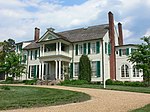Chatham Manor is a Georgian-style mansion home completed in 1771 by farmer and statesman William Fitzhugh, after about three years of construction, on the Rappahannock River in Stafford County, Virginia, opposite Fredericksburg. It was for more than a century the center of a large, thriving plantation and the only private residence in the United States to be visited by George Washington, Thomas Jefferson, Abraham Lincoln, and Dwight D. Eisenhower.
Chatham also reflected the new country's racial tensions. In January 1805, Chatham's slaves overpowered and whipped their overseer and assistants in a minor slave rebellion. An armed posse of white men quickly gathered. They killed one slave in the attack, and two more died trying to escape capture. Two other slaves were deported, likely to the Caribbean or Louisiana, and Fitzhugh soon sold the property.
Five decades later, in 1857, owner Hannah Jones Coalter (the 77-year-old mother of a disabled daughter named Janet) died and attempted to manumit her 93 slaves after making provisions both for her daughter and the slaves. Her relatives sued, claiming that after the Dred Scott decision, slaves were legally incapable of choosing whether to remain enslaved or receive their freedom and enough money to establish themselves in another state. While local judges thought the executors should free the slaves per Hannah's intent, a divided Virginia Supreme Court disagreed. Thus, the executors sold Chatham with its slaves to J. Horace Lacy (husband of Hannah's much younger half-sister Betty). However, soon one enslaved person was allowed to travel to raise money to buy freedom for herself and her small family and succeeded.
During the American Civil War, the Lacys abandoned Chatham. Its strategic site overlooking Fredericksburg briefly served as a U.S. Army headquarters and later as the significant Union hospital during battles for control of the strategic Virginia city and Spotsylvania County en route to the Confederate capital. Due to wartime use and disuse, Chatham fell into significant disrepair. The Lacys ultimately sold Chatham to pay taxes (including on their other estate, Ellwood Manor) in 1872. Saved from destruction as the 20th century began by a series of wealthy American owners, Chatham was refurbished and became a showpiece. The estate was willed to the National Park Service in 1975 and now serves as the headquarters for the Fredericksburg and Spotsylvania National Military Park.










